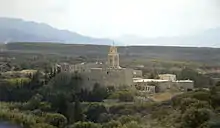Toplou Monastery
Toplou Monastery (Greek: Μονή Τοπλού) is a 15th-century monastery located in a dry and barren area in the Lasithi regional unit, on the eastern part of the island of Crete in Greece. It is about 6 km (3.7 mi) north of the village of Palekastro and 85 km (53 mi) east of Agios Nikolaos. The monastery was originally called Panagia Akrotiriani (Virgin Mary of the Cape), after the nearby Sidero cape. Its current name literally means "with the cannonball", thus called by the Turks for the cannon and cannonballs (Turkish: top) it had in its possession for defensive purposes.
| Toplou Monastery | |
|---|---|
Μονή Τοπλού | |
 General view of Toplou monastery | |
| Religion | |
| Affiliation | Greek Orthodox Church |
| Region | Crete |
| Patron | Virgin Mary and St. John the Theologian |
| Location | |
| Country | Greece |
| Geographic coordinates | 35°13′17.1″N 26°12′57.8″E |
| Architecture | |
| Date established | 15th century |


History
Toplou monastery is one of the most significant monasteries in Crete, dedicated to Panagia (Virgin Mary) and St. John the Theologian. It was founded around the mid 15th century, probably on the ruins of an earlier convent. The monastery was plundered by the knights of Malta in 1530 and shattered in 1612 by a strong earthquake. Due to its strategic position, the senate of the Republic of Venice, then ruler of Crete, decided to financially aid in rebuilding it. The monastery flourished until the surrender of eastern Crete to the Turks in 1646, after which it was abandoned for a long time. In 1704, it acquired special protection privileges from the Patriarch (i.e., stauropegic) and was re-inhabited.
After its monks were slaughtered by Turks in 1821 during the Greek Revolution of Independence, Toplou was again deserted until 1828. In 1866, during the massive Cretan revolt against the Turks, it was once again devastated. During the German occupation of 1941-44, Toplou was providing shelter to resistance fighters and housed their wireless radio. When this was discovered by the Germans, the abbot and two monks were tortured and executed.
Architecture
Having to defend itself from pirates and invaders, Toplou monastery is heavily fortified, being laid out around a courtyard paved with sea pebbles and surrounded by strong, 10 m (33 ft) high square walls. In its present form it extends to about 800 square meters in three floors, divided into cells, guest houses, kitchens and warehouses. The main church (katholikon) is built as a two-nave basilica and the belltower dates back to 1558.
Current status
Despite its turbulent history, Toplou has many works of art to its possession. Today, it hosts an interesting exhibition of Byzantine icons, books and documents, a display of ancient engravings and a collection of artefacts which reflect its role in the historical events that influenced Crete during the last centuries. The monastery possesses a series of about 20 portraits of monks, despotes and igoumens painted by the famous portraitist Thomas Papadoperakis. Many of them have written the recent tragical history of the place. The walls of the monks' dining hall, the "trapezaria", are also adorned with remarkable fresco paintings by the icon painter Manolis Betinakis.
The Cavo Sidero dispute
UK-based Minoan Group (formerly Loyalward Group Plc) plans a €1.2bn construction project on the 25.9 km2 (10.0 sq mi) Cavo Sidero peninsula that is located in the northeastern part of Crete. This land is owned by Toplou monastery and is leased for 80 years. Backed by strong political support, the so-called Cavo Sidero project is advertised as one of the largest tourist investments in Greece. It includes the construction of six tourist villages with 7,000 beds, three golf courses, a conference center a marina plus sport facilities. However, the Cavo Sidero peninsula is a Natura 2000 designated area of particular biodiversity and archaeological importance and home to the Vai natural palm forest, the largest of its kind in Europe. On top of that, it is one of the driest areas on Crete and the large amounts of water that would be required by the developments when in operation will have a tremendous negative impact on the environment.[1][2] Thus, despite the investors assurances that the project has been designed to operate according to the principles of sustainable development, there has been strong opposition against it by the local population and several environmental groups, including World Wide Fund for Nature. Serious doubts about the intentions and the financial strength of the investors have also been raised.[3]
In April 2009, the Supreme Administrative Court accepted the request of about 300 Sitia residents who sought to annul the ministerial decree of 2007, which adopted the environmental impact study for the project. According to the Court, the environmental licensing of the project was not legitimate[4] since the land use planning foresees only a mild tourist development for the area.
See also
References
External links
| Wikimedia Commons has media related to Moni Toplou. |